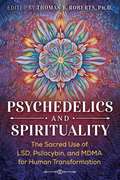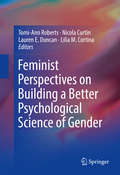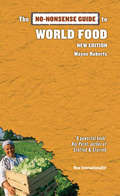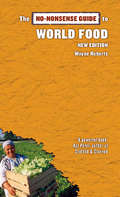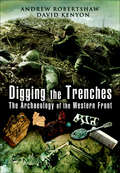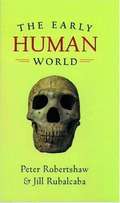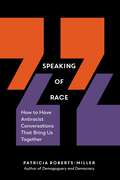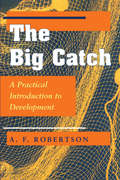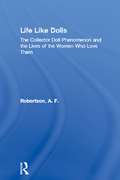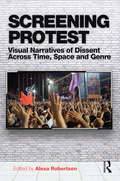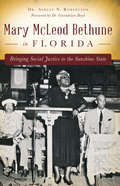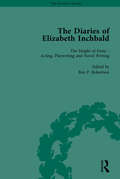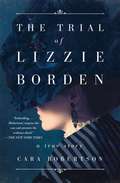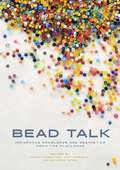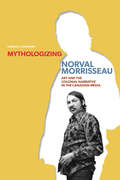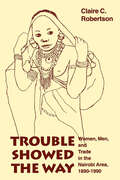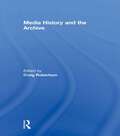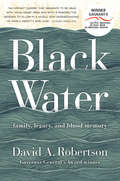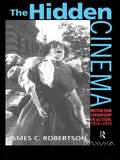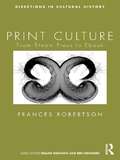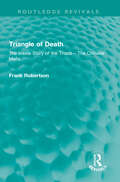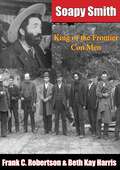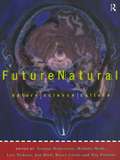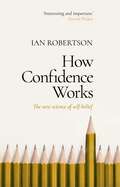- Table View
- List View
Psychedelics and Spirituality: The Sacred Use of LSD, Psilocybin, and MDMA for Human Transformation
by Thomas B. RobertsReveals how psychedelics can facilitate spiritual development and direct encounters with the sacred • With contributions by Albert Hofmann, Huston Smith, Stanislav Grof, Charles Tart, Alexander &“Sasha&” Shulgin, Brother David Steindl-Rast, and many others • Includes personal accounts of Walter Pahnke&’s Good Friday Experiment as well as a 25-year follow-up with its participants • Explores protocols for ceremonial use of psychedelics and the challenges of transforming entheogenic insights into enduring change Modern organized religion is based predominantly on secondary religious experience--we read about others&’ extraordinary spiritual encounters with God but have no direct experience ourselves. Yet there exist powerful sacraments to help us directly experience the sacred, to help us seek out the meaning of being human and our place in the universe, and to help us see the sacred in the world that surrounds us. In this book, more than 25 spiritual leaders, scientists, and psychedelic visionaries examine how we can return to the primary spiritual encounters at the basis of all religions through the guided use of psychedelics. With contributions by Albert Hofmann, Huston Smith, Stanislav Grof, Charles Tart, Alexander &“Sasha&” Shulgin, Brother David Steindl-Rast, Myron Stolaroff, and many others, this book explores protocols for ceremonial and spiritual use of psychedelics, including LSD, psilocybin, ayahuasca, and MDMA, and the challenges of transforming entheogenic insights into enduring change. It examines psychoactive sacraments in the Bible, myths surrounding the use of LSD, and the transformative ayahuasca rituals of Santo Daime. The book also includes personal accounts of Walter Pahnke&’s Good Friday Experiment as well as a 25-year follow-up with its participants. Dispelling fears of inauthentic spirituality, addiction, and ill-prepared encounters with the holy, this book reveals the potential of psychedelics as catalysts for spiritual development, a path through which faith can directly encounter God&’s power, and the beginning of a new religious era based on personal spiritual experience.
Feminist Perspectives on Building a Better Psychological Science of Gender
by Tomi-Ann Roberts Nicola Curtin Lauren E. Duncan Lilia M. CortinaThis timely and thought-provoking collection explores the ways in which psychological science interacts with and addresses gender across varied subdisciplines in the field, from a feminist viewpoint. A particular aim of this volume is to move the conversation of gender in psychology beyond a difference-only paradigm. Veteran and emerging feminist scholars survey the handling of sex and gender issues across psychology, and describe how feminist perspectives and methodologies can and should be applied to enhance the field itself, but also in the service of social justice in the various cultures of corporations, academia, and the global stage. Contributions span theoretical advances, latest empirical findings, and real-world advocacy, with instructive and illuminating first-person accounts detailing challenges and rewards of feminist scholarship and practice in psychology. Throughout the volume, chapters document a dynamic field in its evolution from the traditional, two-dimensional study of gender-based differences to concerted multidisciplinary approaches, to cutting edge feminist theoretical and methodological advances such as intersectionality to understand gender in context. The volume is divided into three distinct sections. The first covers current theory and research in psychological science that considers gender beyond a difference-only paradigm. Then, leading feminist scholars reflect upon their own experiences in their respective subdisciplines. Finally, the third section explores innovative best practices and applications for feminist psychological science. Highlights of the coverage: * Beyond difference: Gender as a quality of social settings. * Adventures in feminist health psychology: Teaching about and conducting feminist psychological science. * Mind the thigh gap? Bringing feminist psychological science to the masses. * Feminist psychologists and institutional change in universities. With its stimulating compilation of theories, research, and applications, Feminist Perspectives On Building A Better Psychological Science of Gender is one of the most forward-thinking and innovative treatments of the field in recent years. It is a significant and important text for all psychologists, women's and gender studies specialists, social science researchers, and all those interested in using evidence-based psychological science to create a more just and equitable world.
The No-Nonsense Guide to World Food: New Edition
by Wayne RobertsWayne Roberts puts under the microscope a global food system that is under strain from climate change and from economic disaster.<P><P>He shows how a world food system based on supermarkets and agribusiness corporations is unsustainable and looks at new models of producing healthy food from all over the world.
No-Nonsense Guide to World Food, 2nd Edition (No-Nonsense Guides #28)
by Wayne RobertsIn this updated edition of The No-Nonsense Guide to World Food Wayne Roberts puts under the microscope a global food system that is under strain from climate change and from economic disaster. He shows how a world food system based on supermarkets and agribusiness corporations is unsustainable and looks at new models of producing healthy food from all over the world.
Digging the Trenches: The Archaeology of the Western Front
by Andrew Robertshaw David KenyonThis comprehensive, illustrated survey of the latest in battlefield archaeology reveals &“intimate insight into the realities of life&” during WWI (Current Archaeology).Modern methods of archaeological, historical, and forensic research have transformed our understanding of the Great War. In Digging the Trenches, battlefield archaeologists Andrew Robertshaw and David Kenyon introduce the reader to this exciting new field and explore many of the remarkable projects that have been undertaken.Robertshaw and Kenyon show how archaeology can be used to reveal the positions of trenches, dugouts and other battlefield features, as well as what life on the Western Front was really like. They also show how individual soldiers are coming into focus as forensic investigation is so highly developed that individuals can be identified and their fates discovered.&“An excellent introduction to the subject…Digging the Trenches is essential reading.&”—Gary Sheffield, Military Illustrated&“What a splendid book this is.&”—Neil Faulkner, Current Archaeology
The Early Human World (The World in Ancient Times #1)
by Peter Robertshaw Jill RubalcabaA six-million-year-old jaw bone in Ethiopia proves to be a piece of the earliest hominid discovered-so far. Big Mama, who used a tree branch to escape from a zoo in Holland, is found sipping chocolate milk at a local restaurant. Nandy, a 50,000-year-old skeleton surrounded by flower pollen in Iraq, casts doubt on the beastly reputation of an early hominid. Found frozen in the Alps, Otzi reveals what people in Europe ate 5,000 years ago. Ardipithecus ramidus kadabba, a chimpanzee, a Neandertal, and the Iceman are just some of the characters who make up The Early Human World. Peter Robertshaw and Jill Rubalcaba tell the story of early human life using an incredible variety of primary sources: 3.5-million-year-old footprints preserved by a volcano provide evidence of our ancestors' walking on two legs. Stone flakes fashioned 2 million years ago prove early hominids used tools. Bears, lions, and rhinoceroses painted in a cave 30,000 years ago reveal our ancestors' artistic side. An 8,500-year-old dog grave shows the extraordinarily long history of man's best friend. This evidence helps archaeologists decipher not just how we came to be the Homo sapiens we are today, but also what life may have been like for our earliest ancestors. The first Australians encountered freakishly gigantic beasts: kangaroos as big as houses and tortoises the size of cars. The Sahara Desert was once a fertile land, supporting herds of cattle, sheep, and goats. The Early Human World takes readers to sites around the world as archaeologists piece together the clues to our past. For grades 6-8.
Speaking of Race: How To Have Antiracist Conversations That Bring Us Together
by Patricia Roberts-Miller“Readers of all levels and backgrounds will appreciate the clarity with which Roberts-Miller approaches a topic so often driven by powerful emotion.”—Choice It’s easy to say that racism is wrong. But it’s surprisingly hard to agree on what it is. Does a tired stereotype in your favorite movie make it racist? Does watching it anyway mean you’re racist? Even among like-minded friends, such discussions can quickly escalate to hurt feelings all around—and when they do, we lose valuable opportunities to fight racism. Patricia Roberts-Miller is a scholar of rhetoric—the art of understanding misunderstandings. In Speaking of Race, she explains why the subject is a “third rail” and how we can do better: We can acknowledge that, in a racist society, racism is not the sole provenance of “bad people.” We can focus on the harm it causes rather than the intent of offenders. And, when someone illuminates our own racist blind spots, we can take it not as a criticism, but as a kindness—and an opportunity to learn and to become less racist ourselves.
The Big Catch: A Practical Introduction To Development
by A. F. RobertsonThis interactive, role-playing case book is an enormously rich and stimulating way of challenging students to think about the problems of development and how development experts go about trying to alleviate them. One of the most innovative and eloquent anthropologists of development, A. F. Robertson has drawn from his extensive field experience to construct a hypothetical scenario of the sort typically encountered by those who are making development decisions.
Life Like Dolls: The Collector Doll Phenomenon and the Lives of the Women Who Love Them
by A. F. RobertsonSince the 1980s there has been a growing billion dollar business producing porcelain collectible dolls. Avertised in Sunday newspapers and mailbox fliers, even Marie Osmond, an avid collector herself, is now promoting her own line of dolls on the Home Shopping Network and sales are soaring. With average price tags of $100 -- and $500 or more for a handcrafted or limited edition doll -- these dolls strike a chord in the hearts of middle-aged and older women, their core buyers, some of whom create "nurseries" devoted to collections that number in the hundreds.Each doll has its own name, identity and "adoption certificate," like Shawna, "who has just learned to stack blocks all by herself," and Bobby, whose "brown, handset eyes shine with mischief and little-boy plans." Exploring the nexus of emotions, consumption and commodification they represent, A. F. Robertson tracks the rise of the porcelain collectible market; interviews the women themselves; and visits their clubs, fairs and homes to understand what makes the dolls so irresistible.Lifelike but freakish; novelties that profess to be antiques; pricey kitsch: These dolls are the product of powerful emotions and big business. Life Like Dolls pursues why middle-class, educated women obsessively collect these dolls and what this phenomenon says about our culture.
Screening Protest: Visual narratives of dissent across time, space and genre
by Alexa RobertsonScreening Protest brings together a range of scholarly perspectives on the study of protest mediations on television and in film. Arguing that the screen is a fruitful, if overlooked, analytical focus, the book explores how visual narratives of protest wander across borders – territorial, temporal and generic. Chapters compare coverage of major protests in recent history by global news channels like Al Jazeera English, BBC World, CNN International and RT. They consider how geopolitical agendas, newsroom culture and the ubiquity of eyewitness footage shape the narration of events such as the ‘Umbrella Revolution’ in Hong Kong, anti-austerity protests in Greece, pro-EU mobilizations in the Ukraine and clashes in Ferguson. A focus on narrative allows authors to compare such news stories with popular cultural depictions of the protester, in films and television series such as The Hunger Games, Robin Hood and Suffragette. Although focussed on the screen, the scope of the book is broad, given its exploration of images distributed worldwide. Written with both scholars and students in mind, Screening Protest will interest researchers in political science, sociology, media and film studies, as well as the general reader interested in current affairs.
Mary McLeod Bethune in Florida: Bringing Social Justice to the Sunshine State
by Ashley N. RobertsonA vibrant biography of the woman who shaped the political climate of Daytona Beach with her civil rights, women’s rights, and education activism.Mary McLeod Bethune was often called the “First Lady of Negro America,” but she made significant contributions to the political climate of Florida as well. From the founding of the Daytona Literary and Industrial School for Training Negro Girls in 1904, Bethune galvanized African American women for change. She created an environment in Daytona Beach that, despite racial tension throughout the state, allowed Jackie Robinson to begin his journey to integrating Major League Baseball less than two miles away from her school. Today, her legacy lives through a number of institutions, including Bethune-Cookman University and the Mary McLeod Bethune Foundation National Historic Landmark. Historian Ashley Robertson explores the life, leadership and amazing contributions of this dynamic activist.
The Diaries of Elizabeth Inchbald Vol 2
by Ben P RobertsonAn energetic woman, Inchbald achieved fame as an actress, novelist, playwright and critic. This work includes her eleven surviving diaries, which record Inchbald's social contacts and professional activities, itemize her day-to-day expenditure, and chart the development of affairs such as the Napoleonic Wars and the trial of Queen Caroline.
The Trial of Lizzie Borden
by Cara RobertsonThe remarkable new account of an essential piece of American mythology—the trial of Lizzie Borden—based on twenty years of research and recently unearthed evidence.The Trial of Lizzie Borden tells the true story of one of the most sensational murder trials in American history. When Andrew and Abby Borden were brutally hacked to death in Fall River, Massachusetts, in August 1892, the arrest of the couple’s younger daughter Lizzie turned the case into international news and her trial into a spectacle unparalleled in American history. Reporters flocked to the scene. Well-known columnists took up conspicuous seats in the courtroom. The defendant was relentlessly scrutinized for signs of guilt or innocence. Everyone—rich and poor, suffragists and social conservatives, legal scholars and laypeople—had an opinion about Lizzie Borden’s guilt or innocence. Was she a cold-blooded murderess or an unjustly persecuted lady? Did she or didn’t she? The popular fascination with the Borden murders and its central enigmatic character has endured for more than one hundred years. Immortalized in rhyme, told and retold in every conceivable genre, the murders have secured a place in the American pantheon of mythic horror, but one typically wrenched from its historical moment. In contrast, Cara Robertson explores the stories Lizzie Borden’s culture wanted and expected to hear and how those stories influenced the debate inside and outside of the courtroom. Based on transcripts of the Borden legal proceedings, contemporary newspaper accounts, unpublished local accounts, and recently unearthed letters from Lizzie herself, The Trial of Lizzie Borden offers a window onto America in the Gilded Age, showcasing its most deeply held convictions and its most troubling social anxieties.
Bead Talk: Indigenous Knowledge and Aesthetics from the Flatlands (paskwāwi masinahikewina/Prairie Writing #1)
by Carmen Robertson Judy Anderson Katherine BoyerSewing new understandings Indigenous beadwork has taken the art world by storm, but it is still sometimes misunderstood as static, anthropological artifact. Today’s prairie artists defy this categorization, demonstrating how beads tell stories and reclaim cultural identity. Whether artists seek out and share techniques through YouTube videos or in-person gatherings, beading fosters traditional methods of teaching and learning and enables intergenerational transmissions of pattern and skill. In Bead Talk, editors Carmen Robertson, Judy Anderson, and Katherine Boyer gather conversations, interviews, essays, and full-colour reproductions of beadwork from expert and emerging artists, academics, and curators to illustrate the importance of beading in contemporary Indigenous arts. Taken together, the book poses and responds to philosophical questions about beading on the prairies: How do the practices and processes of beading embody reciprocity, respect, and storytelling? How is beading related to Indigenous ways of knowing? How does beading help individuals reconnect with the land? Why do we bead? Showcasing beaded tumplines, text, masks, regalia, and more, Bead Talk emphasizes that there is no one way to engage with this art. The contributors to this collection invite us all into the beading circle as they reshape how beads are understood and stitch together generations of artists.
Mythologizing Norval Morrisseau: Art and the Colonial Narrative in the Canadian Media
by Carmen L. Robertson"Mythologizing Norval Morrisseau" examines the complex identities assigned to Anishinaabe artist Norval Morrisseau. Was he an uneducated artist plagued by alcoholism and homelessness? Was Morrisseau a shaman artist who tapped a deep spiritual force? Or was he simply one of Canada’s most significant artists? Carmen L. Robertson charts both the colonial attitudes and the stereotypes directed at Morrisseau and other Indigenous artists in Canada’s national press. Robertson also examines Morrisseau’s own shaping of his image. An internationally known and award-winning artist from a remote area of northwestern Ontario, Morrisseau founded an art movement known as Woodland Art developed largely from Indigenous and personal creative elements. Still, until his retrospective exhibition at the National Gallery of Canada in 2006, many Canadians knew almost nothing about Morrisseau’s work. Using discourse analysis methods, Robertson looks at news stories, magazine articles, and film footage, ranging from Morrisseau’s first solo exhibition at Toronto’s Pollock Gallery in 1962 until his death in 2007 to examine the cultural assumptions that have framed Morrisseau.
Trouble Showed the Way: Women, Men, And Trade In The Nairobi Area, 1890 - 1990
by Claire Cone Robertson"Robertson's book represents a powerful contribution to African social, economic, and women's history. Highly recommended." --Choice"An important resource for anyone interested in the history of women and trade in modern Kenya...." --International Journal of African Historical Studies"... a landmark study, meticulously executed and written.... it will have a wide impact on some of the most significant questions facing the disciplines of history, anthropology, political science, and development economics." --Gracia ClarkHerskovitz Award-winner Claire Robertson employs a variety of approaches to analyze and weave together this wide-ranging study. Her book provides an extensive case study of historical transformations in gender, agriculture, residence, and civil society. Based on archival documents, library sources (fiction and nonfiction, primary and secondary), surveys and oral histories, participant observation, and quantitative and qualitative analysis, Robertson breaks new ground by focusing on traders in one commodity, dried staples, and comparing and contrasting the evolution of women's trade with men's trade.
Media History and the Archive
by Craig RobertsonBy the time readers encounter academic history in the form of books and articles, all that tends to be left of an author’s direct experience with archives is pages of endnotes. Whether intentionally or not, archives have until recently been largely thought of as discrete collections of documents, perhaps not neutral but rarely considered to be historical actors.This book brings together top media scholars to rethink the role of the archive and historical record from the perspective of writing media history. Exploring the concept of the archive forces a reconsideration of what counts as historical evidence. In this analysis the archive becomes a concept that allows the authors to think about the acts of classifying, collecting, storing, and interpreting the sources used in historical research. The essays included in this volume, from Susan Douglas, Lisa Gitelman, John Nerone, Jeremy Packer, Paddy Scannell, Lynn Spigel, and Jonathan Sterne, focus on both the theoretical and practical ways in which the archive has affected how media is thought about as an object for historical analysis.This book was published as a special issue of The Communication Review.
Black Water: Family, Legacy, and Blood Memory
by David A. Robertson“An instant classic that demands to be read with your heart open and with a perspective widened to allow in a whole new understanding of family, identity, and love.” —Cherie DimalineA son who grew up away from his Indigenous culture takes his Cree father on a trip to their family's trapline, and finds that revisiting the past not only heals old wounds but creates a new future.The son of a Cree father and a non-Indigenous mother, David A. Robertson was raised with virtually no knowledge or understanding of his family’s Indigenous roots. His father, Don, spent his early childhood on a trapline in the bush northeast of Norway House, Manitoba, where his first teach was the land. When his family was moved permanently to a nearby reserve, Don was not permitted to speak Cree at school unless in secret with his friends and lost the knowledge he had been gifted while living on his trapline. His mother, Beverly, grew up in a small Manitoba town with not a single Indigenous family in it. Then Don arrived, the new United Church minister, and they fell in love. Structured around a father-son journey to the northern trapline where Robertson and his father will reclaim their connection to the land, Black Water is the story of another journey: a young man seeking to understand his father's story, to come to terms with his lifelong experience with anxiety, and to finally piece together his own blood memory, the parts of his identity that are woven into the fabric of his DNA.
The Hidden Cinema: British Film Censorship in Action 1913-1972 (Cinema and Society)
by Dr James Robertson James RobertsonHow does film censorship work in Britain? Jim Robertson's new paperback edition of The Hidden Cinema argues that censorship has had a far greater influence on British film history than is often apparent, creating the `hidden cinema' of the title. Robertson charts the role of the British Board of Film Censors, established in 1913, and the histories of a variety of noteworthy films including Battleship Potemkin and No Orchids for Miss Blandish and revealing how censorship continues to exert a marked influence on many important films - like the controversial A Clockwork Orange - some of which have now vanished from British screens altogether. This edition includes a brand new section on Bernardo Bertolucci's Last Tango in Paris, immediately engulfed in censorship wrangles on its release in 1972.
Rhythms of Labour: Music at Work in Britain
by Emma Robertson Marek Korczynski Michael PickeringWhether for weavers at the handloom, labourers at the plough, or factory workers on the assembly line, music has often been a key texture in people's working lives. This book is the first to explore the rich history of music at work in Britain and charts the journey from the singing cultures of pre-industrial occupations, to the impact and uses of the factory radio, via the silencing effect of industrialisation. The first part of the book discusses how widespread cultures of singing at work were in pre-industrial manual occupations. The second and third parts of the book show how musical silence reigned with industrialisation, until the carefully controlled introduction of Music While You Work in the 1940s. Continuing the analysis to the present day, Rhythms of Labour explains how workers have clung to and reclaimed popular music on the radio in desperate and creative ways.
Print Culture: From Steam Press to Ebook (Directions in Cultural History)
by Frances RobertsonWith the advent of new digital communication technologies, the end of print culture once again appears to be as inevitable to some recent commentators as it did to Marshall McLuhan. And just as print culture has so often been linked with the rise of modern industrial society, so the alleged demise of print under the onslaught of new media is often also correlated with the demise of modernity. This book charts the elements involved in such claims—print, culture, technology, history—through a method that examines the iconography of materials, marks and processes of print, and in this sense acknowledges McLuhan’s notion of the medium as the bearer of meaning. Even in the digital age, many diverse forms of print continue to circulate and gain meaning from their material expression and their history. However, Frances Robertson argues that print culture can only be understood as a constellation of diverse practices and therefore discusses a range of print cultures from 1800 the present ‘post-print’ culture. The book will be of interest to undergraduate and postgraduate students within the areas of cultural history, art and design history, book and print history, media studies, literary studies, and the history of technology.
Triangle of Death: The Inside Story of the Triads – The Chinese Mafia (Routledge Revivals)
by Frank RobertsonTriangle of Death (1977) examines the growth of the international heroin trade, and its control by the Chinese secret societies known as Triads. It looks at the Triads active in Hong Kong, the Golden Triangle and Amsterdam, and shows how these groups have spread across the Western world.
Soapy Smith: King of the Frontier Con Men
by Frank C. Robertson Beth Kay HarrisJefferson Randolph "Soapy" Smith was the slickest article that ever hit the West. He set up his tripod and suitcase on a Denver street corner in the 1880s and started his spiel. The "suckers" flocked around and got thoroughly taken. Everyone listened to Soapy and he began laying down his own brand of law, soon commanding a band of criminal characters whom he protected through his influence with politicians and policewomen on his payroll. He became America's first racketeer, eventually leading the Skagway underworld until a bullet ended his career.
Futurenatural: Nature, Science, Culture (FUTURES: New Perspectives for Cultural Analysis)
by George Robertson Melinda Mash Lisa Tickner Jon Bird Barry Curtis Tim PutnamWe are living in an age when 'nature' seems to be on the brink of extinction yet, at the same time, 'nature' is becoming increasingly ubiquitous and unstable as a category for representation and debate.Futurenatural brings together leading theorists of culture and science to discuss the concept of 'nature' - its past, present and future. Contributors discuss the impact on our daily life of recent developments on biotechnologies, electronic media and ecological politics. Increasingly, scientific theories and models have been taken up as cultural metaphors that have material effects in transforming 'ways of seeing' and 'structures of feeling'.The book addresses the issue of whether political and cultural debates about the body and environment can take place without reference to 'nature' or the 'natural'. This collection considers how we might 'think' a future developing from emergent scientific theories and discourses. What cultural forms may be produced when new knowledges challenge and undermine traditional ways of conceiving the 'natural'.
How Confidence Works: The new science of self-belief
by Ian Robertson* Confidence makes your brain work better and boosts your performance* Confidence acts like a mini-antidepressant, lifting your mood* Confidence is contagious* Confidence is anxiety's greatest antidote* Confidence is a set of habits that feel fake at first but become real with practice* Confidence makes boys bullsh*t more than girls* Overconfidence can have disastrous consequences_________'Brilliant ... it will change how you think about confidence.' Johann Hari'Important for everyone but crucial for women.' Mary Robinson'Interesting and important.' Steven Pinker__________Imagine we could discover something that could make us richer, healthier, longer-living, smarter, kinder, happier, more motivated and more innovative. Ridiculous, you might say... What is this elixir?Confidence.If you have it, it can empower you to reach heights you never thought possible. But if you don't, it can have a devastating effect on your future. Confidence lies at the core of what makes things happen.Exploring the science and neuroscience behind confidence that has emerged over the last decade, clinical psychologist and neuroscientist Professor Ian Robertson tells us how confidence plays out in our minds, our brains and indeed our bodies. He explains where it comes from and how it spreads - with extraordinary economic and political consequences. And why it's not necessarily something you are born with, but something that can be learned.__________'Rich stories and change-inspiring examples for every kind of performer.' Pippa Grange'Appealing... ranges from neuroscience to politics.' Nature
